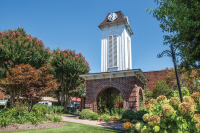Hemlock Initiative looks for solution to adelgid tragedy
 A trio of projects will launch renewed efforts to save the eastern hemlock following awards of $75,000 under the Hemlock Restoration Initiative.
A trio of projects will launch renewed efforts to save the eastern hemlock following awards of $75,000 under the Hemlock Restoration Initiative.
Dying in droves from the invasive hemlock wooly adelgid, hemlock trees have long been a stalwart of Appalachian forests and an important ecological anchor. Dead hemlocks can negatively affect nesting songbirds, trout populations, homeowners and tourism. The goal of the Hemlock Restoration Initiative is to find a solution that allows hemlocks to survive to maturity by 2025.
Three promising projects have each received $25,000. They were selected due to their complementary strategies: treat hemlocks chemically until more lasting solutions are available, ramp up release of predator beetles to provide long-term adelgid control, and meanwhile search for native resistance or tolerance. The projects are:
• Southwestern N.C. Resource Conservation and Development Council, to create a facility to screen hemlocks for adelgid resistance or tolerance.
• Blue Ridge Parkway Foundation, to expand chemical treatment of hemlock stands along the Blue Ridge Parkway in North Carolina.
• Blue Ridge Resource Conservation and Development Council, to train community groups and land trusts to release predator beetles.
The Hemlock Restoration Initiative is being funded with settlement money from a federal lawsuit against the Tennessee Valley Authority for causing air pollution in WNC from its coal-fired power plants. The money is being used for a variety of projects. The hemlock initiative is being managed by WNC Communities.





